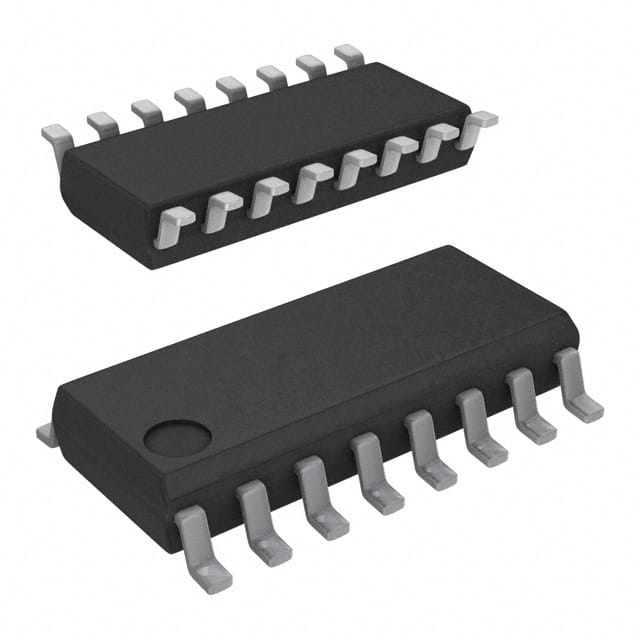Consulte las especificaciones para obtener detalles del producto.

SN74AHC138DR
Product Overview
- Category: Integrated Circuit
- Use: Decoder/Demultiplexer
- Characteristics: High-Speed, Low-Power, 3-to-8 Line Decoder/Demultiplexer
- Package: SOIC (Small Outline Integrated Circuit)
- Essence: Decodes a 3-bit binary input to one of eight outputs
- Packaging/Quantity: Tape and Reel, 2500 pieces per reel
Specifications
- Supply Voltage Range: 2 V to 5.5 V
- High-Level Input Voltage: 2 V to VCC + 0.5 V
- Low-Level Input Voltage: -0.5 V to 0.5 V
- High-Level Output Current: -6 mA
- Low-Level Output Current: 6 mA
- Operating Temperature Range: -40°C to 85°C
Detailed Pin Configuration
The SN74AHC138DR has the following pin configuration:
- GND (Ground)
- A0 (Input A0)
- A1 (Input A1)
- A2 (Input A2)
- E1 (Enable Input 1)
- Y0 (Output Y0)
- Y1 (Output Y1)
- Y2 (Output Y2)
- Y3 (Output Y3)
- Y4 (Output Y4)
- Y5 (Output Y5)
- Y6 (Output Y6)
- Y7 (Output Y7)
- VCC (Supply Voltage)
Functional Features
- Decodes a 3-bit binary input to one of eight outputs
- Active-Low Enable inputs for easy control of output selection
- High-speed operation with minimal propagation delay
- Low power consumption, suitable for battery-powered devices
- Schmitt-trigger inputs for noise immunity
Advantages and Disadvantages
Advantages: - High-speed operation allows for quick decoding of input signals - Low power consumption makes it suitable for portable devices - Schmitt-trigger inputs provide noise immunity, ensuring reliable operation
Disadvantages: - Limited to 3-bit binary input decoding - May not be suitable for applications requiring larger decoding capabilities
Working Principles
The SN74AHC138DR is a decoder/demultiplexer integrated circuit that takes a 3-bit binary input and selects one of eight outputs based on the input combination. The active-low enable inputs (E1) control the output selection. When the enable input is low, the corresponding output is enabled, and when the enable input is high, the output is disabled.
The inputs A0, A1, and A2 determine the binary value to be decoded. The selected output (Y0 to Y7) will be low while all other outputs remain high. This allows for efficient routing of signals in digital circuits.
Detailed Application Field Plans
The SN74AHC138DR can be used in various applications, including:
- Address Decoding: Selecting specific memory or peripheral devices based on address lines.
- Data Demultiplexing: Distributing data from a single source to multiple destinations.
- Signal Routing: Controlling the flow of signals in complex digital systems.
- Control Logic: Implementing control functions in microcontrollers and digital systems.
Detailed and Complete Alternative Models
Some alternative models to the SN74AHC138DR include:
- CD74HC138E: High-Speed CMOS Logic 3-to-8 Line Decoder/Demultiplexer
- 74HCT138N: 3-to-8 Line Decoder/Demultiplexer with Latch Enable
- MC74HC138AN: High-Speed CMOS Logic 3-to-8 Line Decoder/Demultiplexer
These alternative models offer similar functionality and can be used as replacements depending on specific requirements.
Word count: 446 words
Enumere 10 preguntas y respuestas comunes relacionadas con la aplicación de SN74AHC138DR en soluciones técnicas
Sure! Here are 10 common questions and answers related to the application of SN74AHC138DR in technical solutions:
Q: What is SN74AHC138DR? A: SN74AHC138DR is a 3-to-8 line decoder/demultiplexer integrated circuit (IC) that can be used in various digital logic applications.
Q: What is the purpose of SN74AHC138DR? A: SN74AHC138DR is used to decode binary information from a microcontroller or other digital device into multiple output lines, enabling selection of one out of eight possible outputs.
Q: How does SN74AHC138DR work? A: The IC takes three input lines (A0, A1, and A2) and generates eight output lines (Y0-Y7) based on the binary value of the inputs. The selected output line is determined by the combination of the input lines.
Q: What is the voltage range supported by SN74AHC138DR? A: SN74AHC138DR supports a wide voltage range of 2V to 5.5V, making it compatible with various digital systems.
Q: Can SN74AHC138DR be used for both decoding and demultiplexing? A: Yes, SN74AHC138DR can be used as both a decoder and a demultiplexer, depending on the application requirements.
Q: What is the maximum output current of SN74AHC138DR? A: SN74AHC138DR has a maximum output current of 8mA, which allows it to drive standard TTL or CMOS logic levels.
Q: Can SN74AHC138DR be cascaded to increase the number of outputs? A: Yes, multiple SN74AHC138DR ICs can be cascaded together to increase the number of outputs beyond eight.
Q: What is the typical propagation delay of SN74AHC138DR? A: The typical propagation delay of SN74AHC138DR is around 5ns, making it suitable for high-speed applications.
Q: Is SN74AHC138DR available in different package options? A: Yes, SN74AHC138DR is available in various package options, including SOIC, TSSOP, and PDIP.
Q: What are some common applications of SN74AHC138DR? A: SN74AHC138DR is commonly used in address decoding, memory selection, data routing, and general-purpose digital logic circuits.
Please note that these answers are general and may vary depending on specific datasheet specifications and application requirements.

